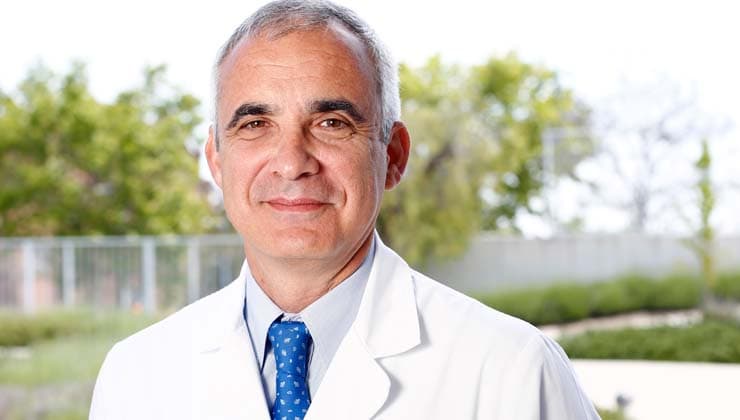Age-related macular degeneration: we are promoting research projects with gene therapy and artificial vision
18 de March de 2021
Age-related macular degeneration (AMD) is a chronic disease that requires early diagnosis and, in many cases, periodic treatment to slow its progression.
This aspect is especially important during a pandemic, as, according to a recent study by the Miranza group, 75% of Spaniards have not seen an ophthalmologist in recent months. One of the main consequences is that this fact does not allow patients with chronic eye diseases, such as AMD, to carry out ophthalmological observation in a timely manner and stop this pathology, the development of which occurs quickly, causing very serious visual impairment, in many cases.
At present, the AMD:
• is the leading cause of vision loss in people over 65.
• affects about 700,000 people in Spain.
Major risk factors: age and family history
One of the key aspects of AMD is that it is associated with many factors, the main one being age. “This means that very few people are affected between the ages of 50-60,” explains Dr. Rafael Navarro, ophthalmologist, expert on this degenerative retinal pathology, at the Miranza Group Microsurgery Ocular Institute and Director of Research and Development Group.

Age is the main risk factor for AMD
Likewise, “we know that there is a certain genetic predisposition: 3-6 times higher if you have a sick first-degree relative,” adds the ophthalmologist.
The main signs of AMD
As for vision with AMD, it is usually associated with a spot in the center, which grows until it causes significant visual impairment as the disease progresses. This symptom occurs due to the fact that pathology affects the central region of the retina – the macula. However, as Dr. Navarro points out, “It is important to remember that this visual impairment is common in people with severe AMD.” Other signs that may indicate the onset of AMD include:
- loss of vision
- perceive crooked or distorted lines (a characteristic symptom of some types of AMD)
- reduced sensitivity to contrast and difficulty adapting to changes in lighting, for example, when moving from open to closed space.

Dr. Rafael Navarro, AMD Expert, from MOI Miranza Group.
Early diagnosis of AMD is important because treatment is most effective in less advanced cases. Therefore, periodic ophthalmic examinations are key
Dr. Rafael Navarro
Current treatments for AMD
There are two types of AMD:
- the wet form, which has been treated for years with regular injections of drugs called antiangiogens. They are used inside the eye of the affected patient, they can stop the disease and, in many cases, the patient can maintain and even restore vision.
- Unfortunately, the dry form of AMD is not cured. However, it develops more slowly than wet AMD, and the only therapy that ophthalmologists can prescribe is certain antioxidant supplements that protect the macula.

Taking antioxidants for dry AMD
Antioxidants help slow the development of dry AMD, but are not effective treatments
Dr. Rafael Navarro
Research projects: gene therapy and computer vision
The Microsurgery Ocular Institute (MOI), the Miranza group, conducts clinical research under the guidance of the MOI Foundation, which aims to treat the disease with a variety of therapeutic strategies and in accordance with the clinical profile of the patient:
- One of these is gene therapy for a type of dry AMD associated with a specific genetic change, and we do this together with our Genetics Department. As the project progresses, it will be extended to other groups of affected people and will consist in replacing the altered gene with a healthy one, and we hope that this will give very good results.
- Another of the ongoing projects is aimed at people with very low vision, including those due to dry AMD. It will involve implanting a chip under the retina, which will generate an electrical impulse, which in turn will stimulate it. The goal is for the patient to be able to perceive images using a micro-camera installed in their own glasses. The preliminary studies were very promising, as some patients re-read them after implantation.
- There are also planned other studies related to intraocular injections for different types of AMD: to slow the development of the dry form and improve the existing ones in the case of the wet form.
We hope that all these projects will help us improve the vision and quality of life of our patients in the not too far future
Dr. Rafael Navarro
IMO Institute of Ocular Microsurgery
Josep María Lladó, 3
08035 Barcelona
Phone: (+34) 934 000 700
E-mail: international@imo.es
See map on Google Maps
By car
GPS navigator coordinates:
41º 24’ 38” N – 02º 07’ 29” E
Exit 7 of the Ronda de Dalt (mountain side). The clinic has a car park with more than 200 parking spaces.
By bus
Autobus H2: Rotonda de Bellesguard, parada 1540
Autobus 196: Josep Maria Lladó-Bellesguard, parada 3191
Autobuses H2, 123, 196: Ronda de Dalt – Bellesguard, parada 0071
How to arrive at IMO from:
IMO Madrid
C/ Valle de Pinares Llanos, 3
28035 Madrid
Phone: (+34) 910 783 783
See map in Google Maps
Public transport
Metro Lacoma (líne 7)
Autobuses:
- Lines 49 & 64, stop “Senda del Infante”
- Line N21, stop “Metro Lacoma”
Timetables
Patient care:
Monday to Friday, 8 a.m. to 8 p.m.
IMO Andorra
Av. de les Nacions Unides, 17
AD700 Escaldes-Engordany, Andorra
Phone: (+376) 688 55 44
See map in Google Maps
IMO Manresa
C/ Carrasco i Formiguera, 33 (Baixos)
08242 – Manresa
Tel: (+34) 938 749 160
See map in Google Maps
Public transport
FGC. Line R5 & R50 direction Manresa. Station/Stop: Baixador de Manresa
Timetables
Monday to Friday, 08:30 A.M – 13:30 PM / 15:00 PM – 20:00 PM




